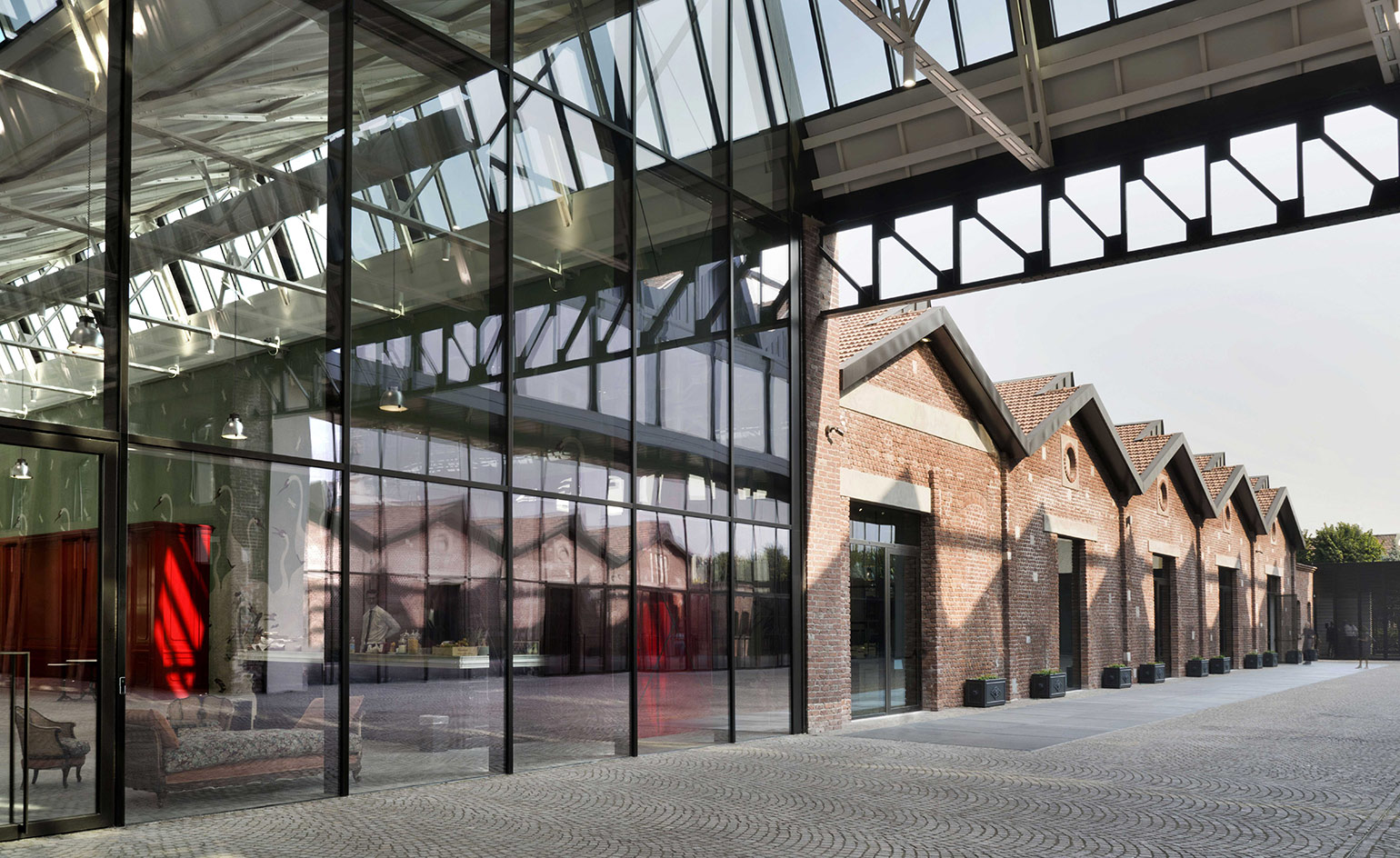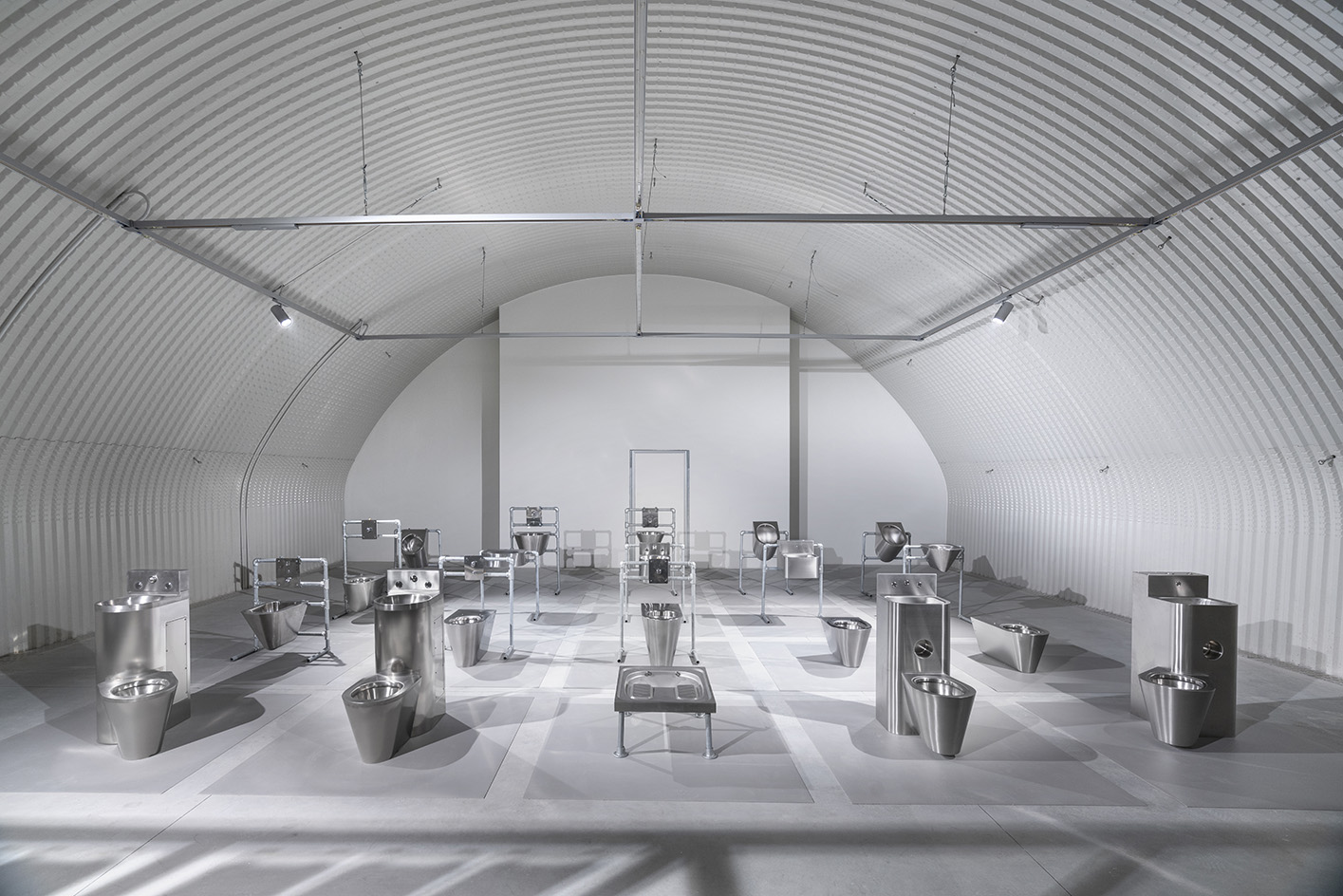In a former aircraft factory, Gucci’s new creative hub takes flight

The Caproni aeronautical factory complex has been restored, renovated and refreshed by Piuarch to create the Gucci Hub, a new Milanese home for the brand. Combining contemporary architecture with the original factory buildings – which date back to 1915, just six years prior to the founding of Gucci in 1921 – the modern renovation of the Caproni site is a celebration of Gucci and its culture, as currently driven by creative director Alessandro Michele (who designed the Hub's interiors).
Rolling out over 35,000 sq m, the complex encompasses offices, showrooms, a venue for shows, and photography and graphic studios, offering a space distinct from the Gucci HQ in Florence and the design office in Rome. The architects struck a balance between preserving the original structures, built for aircraft manufacturing, and designing a contemporary space for a modern workforce. A line of sheds, full of natural light and with exposed brick facades, were repurposed and the vast 3,850 sq m hangar was renovated to host shows.

With renewable energy sourced from a photovoltaic solar system, the buildings are smart and sustainable
Piuarch’s ‘industrial archaeology’ involved demolishing building additions from the 1960s and 70s, which made way for lime-tree-lined patios connecting the site to the public promenade, and a central plaza with vertical gardens enhancing the working environment for the 250 Gucci employees based at the hub. A new six-storey office block is at the heart of the design, its glass facade and dark metal brise-soleil harmonising with the original metal structural parts and crowning, cast in the same material across the red brick walls.

The interiors reflect Gucci creative director Alessandro Michele’s eclectic aesthetic
It’s impossible not to compare the project to the nearby Fondazione Prada – located in a former gin distillery 15 minutes drive away, established in 1910 and renovated by OMA in 2015. While the two locations have broad conceptual similarities (they're both renovations of old industrial buildings), the Gucci Hub preserves the industrial spirit of its past through the uniform simplicity of the structures and the strong continuous zigzag of the shed roofs.
Through its collaborations with other fashion houses (such as Dolce & Gabanna, and Givenchy), Piuarch has demonstrated its deft ability to communicate a brand identity through a building. With no small success, the firm has conceived a contemporary vision within an historic setting for the Gucci Hub.

After Gucci acquired the site at 79 Via Mecenate in 2013, Piuarch led a meticulous restoration of the original Caproni factory buildings

The designers sought to create a defined personality for each space

The Gucci Hub is well equipped for press and visitors

The Caproni factory was an aircraft production centre until 1950
INFORMATION
For more information, visit the Piuarch website and the Gucci website
Wallpaper* Newsletter
Receive our daily digest of inspiration, escapism and design stories from around the world direct to your inbox.
Harriet Thorpe is a writer, journalist and editor covering architecture, design and culture, with particular interest in sustainability, 20th-century architecture and community. After studying History of Art at the School of Oriental and African Studies (SOAS) and Journalism at City University in London, she developed her interest in architecture working at Wallpaper* magazine and today contributes to Wallpaper*, The World of Interiors and Icon magazine, amongst other titles. She is author of The Sustainable City (2022, Hoxton Mini Press), a book about sustainable architecture in London, and the Modern Cambridge Map (2023, Blue Crow Media), a map of 20th-century architecture in Cambridge, the city where she grew up.
-
 Eight designers to know from Rossana Orlandi Gallery’s Milan Design Week 2025 exhibition
Eight designers to know from Rossana Orlandi Gallery’s Milan Design Week 2025 exhibitionWallpaper’s highlights from the mega-exhibition at Rossana Orlandi Gallery include some of the most compelling names in design today
By Anna Solomon
-
 Nikos Koulis brings a cool wearability to high jewellery
Nikos Koulis brings a cool wearability to high jewelleryNikos Koulis experiments with unusual diamond cuts and modern materials in a new collection, ‘Wish’
By Hannah Silver
-
 A Xingfa cement factory’s reimagining breathes new life into an abandoned industrial site
A Xingfa cement factory’s reimagining breathes new life into an abandoned industrial siteWe tour the Xingfa cement factory in China, where a redesign by landscape specialist SWA Group completely transforms an old industrial site into a lush park
By Daven Wu
-
 2026 Olympic and Paralympic Torches: in Carlo Ratti's minimalism ‘the flame is the protagonist’
2026 Olympic and Paralympic Torches: in Carlo Ratti's minimalism ‘the flame is the protagonist’The 2026 Olympic and Paralympic Torches for the upcoming Milano Cortina Games have been revealed, designed by architect Carlo Ratti to highlight the Olympic flame
By Ellie Stathaki
-
 Anni Albers' weaving magic offers a delightful 2-in-1 modernist showcase in Milan
Anni Albers' weaving magic offers a delightful 2-in-1 modernist showcase in MilanA Milan Design Week showcase of Anni Albers’ weaving work, brought to life by Dedar with the Josef & Anni Albers Foundation, brings visitors to modernist icon, the BBPR-designed Torre Velasca
By Ellie Stathaki
-
 Milan Design Week: ‘A Beat of Water’ highlights the power of the precious natural resource
Milan Design Week: ‘A Beat of Water’ highlights the power of the precious natural resource‘A Beat of Water’ by BIG - Bjarke Ingels Group and Roca zooms in on water and its power – from natural element to valuable resource, touching on sustainability and consumption
By Ellie Stathaki
-
 This Milan Design Week installation invites you to tread barefoot inside a palazzo
This Milan Design Week installation invites you to tread barefoot inside a palazzoAt Palazzo Litta, Moscapartners and Byoung Cho launch a contemplative installation on the theme of migration
By Ellie Stathaki
-
 Milan Design Week: Dropcity challenges detention space design with 'Prison Times'
Milan Design Week: Dropcity challenges detention space design with 'Prison Times'Dropcity's inaugural exhibition 'Prison Times – Spatial Dynamics of Penal Environments', opens a few days before the launch of Milan Design Week and discusses penal environments and their spatial design
By Ellie Stathaki
-
 The upcoming Zaha Hadid Architects projects set to transform the horizon
The upcoming Zaha Hadid Architects projects set to transform the horizonA peek at Zaha Hadid Architects’ future projects, which will comprise some of the most innovative and intriguing structures in the world
By Anna Solomon
-
 Is biodesign the future of architecture? EcoLogicStudio thinks so
Is biodesign the future of architecture? EcoLogicStudio thinks soWe talk all things biodesign with British-Italian architecture practice ecoLogicStudio, discussing how architecture can work with nature
By Shawn Adams
-
 Meet Carlo Ratti, the architect curating the 2025 Venice Architecture Biennale
Meet Carlo Ratti, the architect curating the 2025 Venice Architecture BiennaleWe meet Italian architect Carlo Ratti, the curator of the 2025 Venice Architecture Biennale, to find out what drives and fascinates him ahead of the world’s biggest architecture festival kick-off in May
By Ellie Stathaki